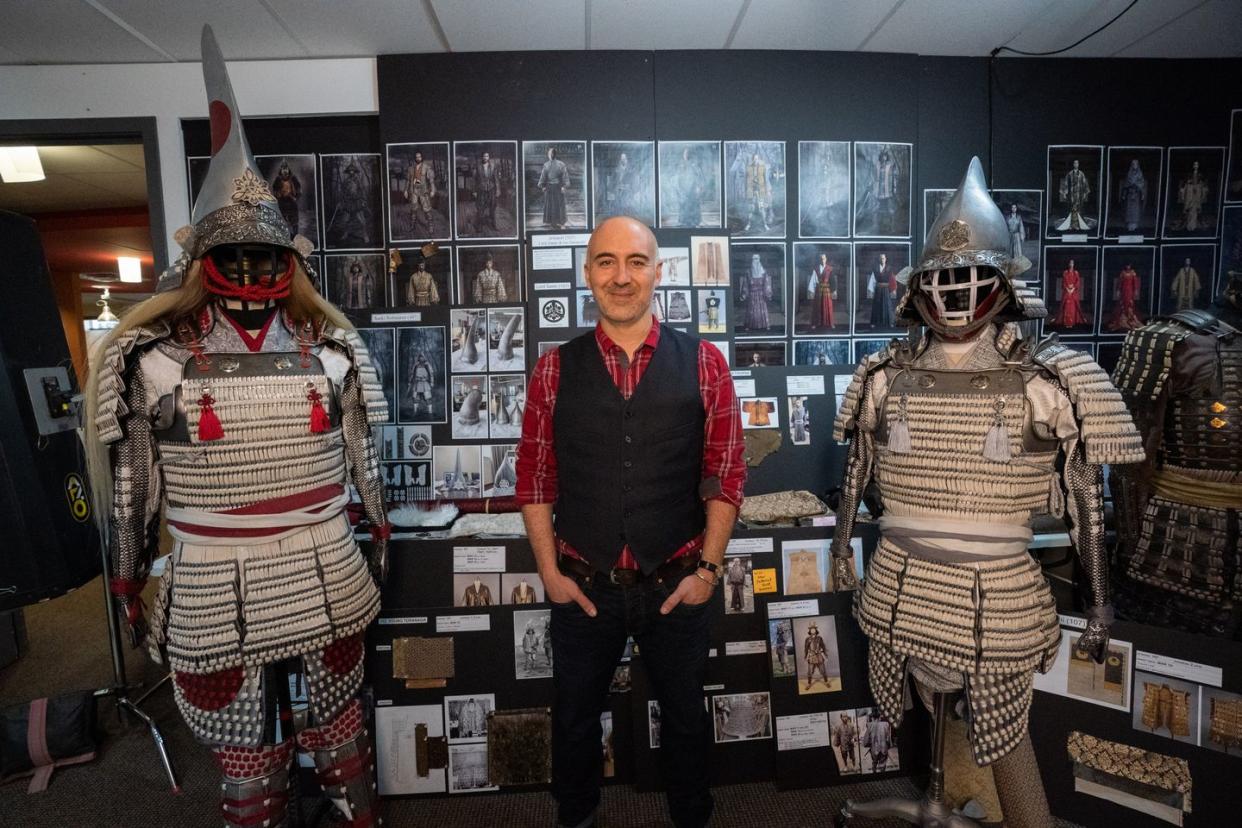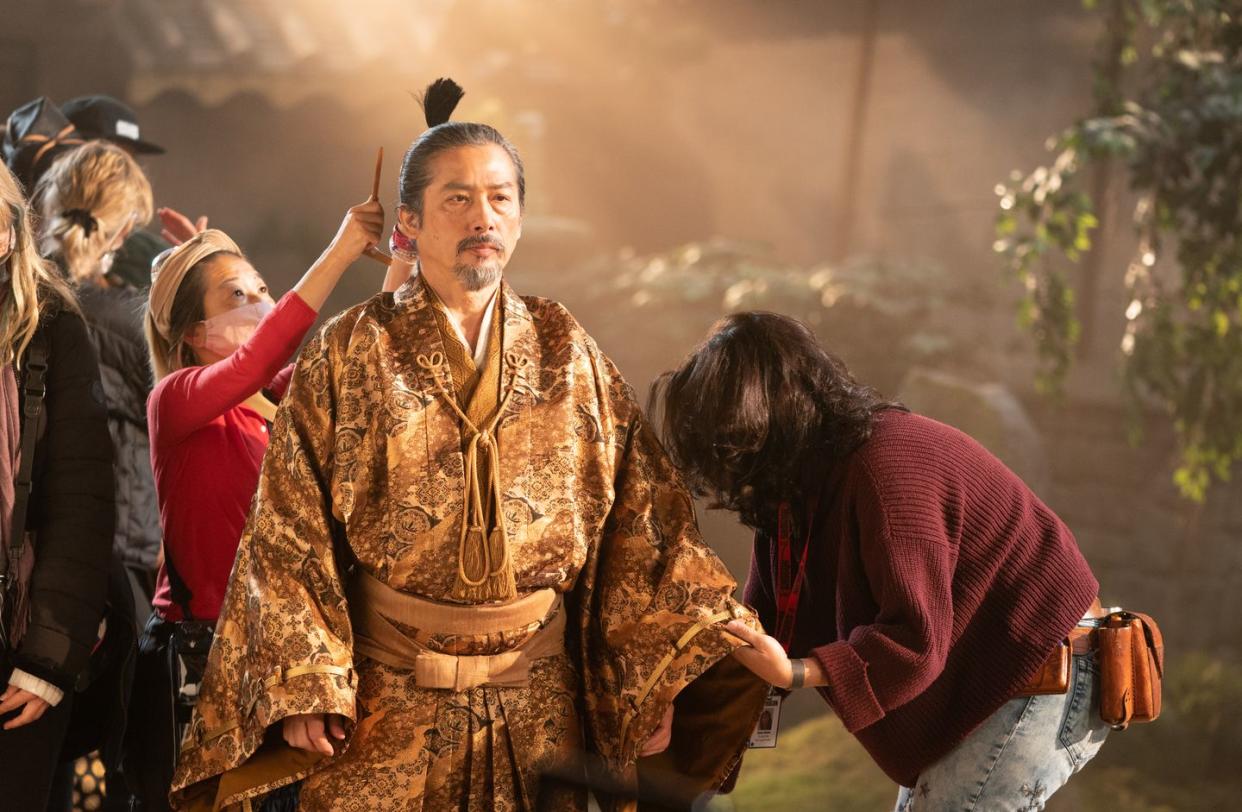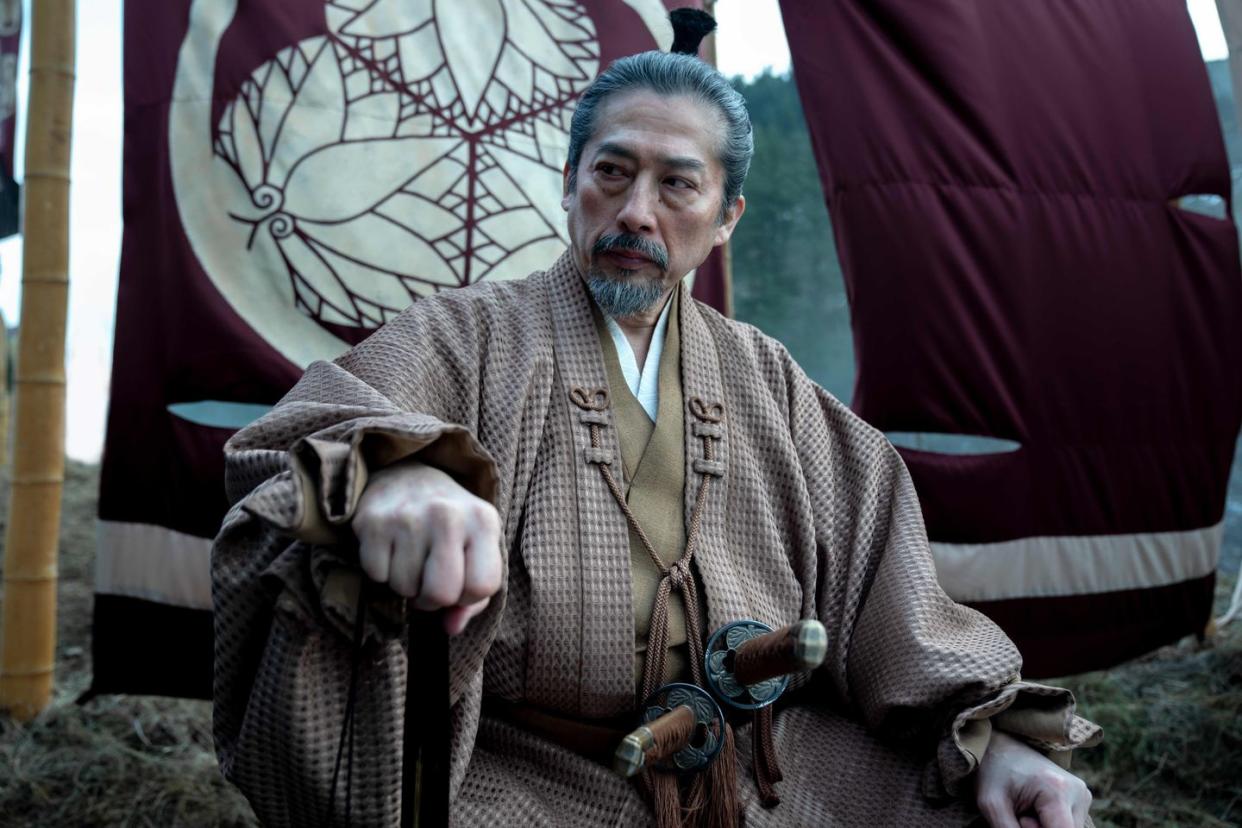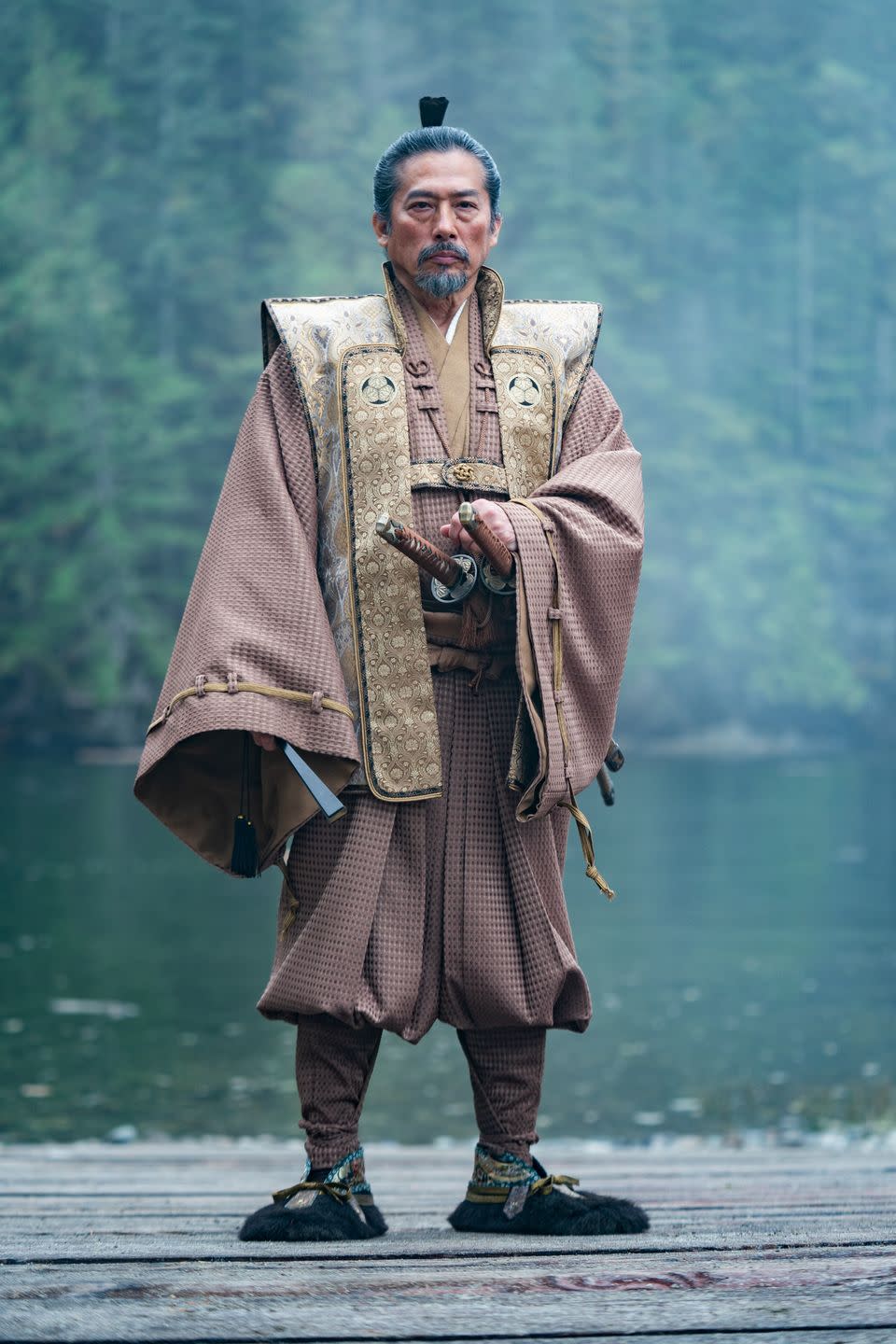How FX’s ‘Shōgun’ Made ‘Thousands’ of Perfect Costumes
"Hearst Magazines and Yahoo may earn commission or revenue on some items through these links."
PERIOD PIECES ARE nothing without smart attention to detail—right down to the threads. That’s something Shōgun costume designer Carlos Rosario knew right out of the gate when he was approached to design and outfit whole armies (!) worth of costumes for the impressive FX limited series, which is about to reach its conclusion. As the weeks have stretched on, captivating its audience, part of what’s made the show so compelling outside of its gripping story and rich characters are Rosario’s costumes, all of which feel like works of art.
Rosario's passion for both the series and his own craft shines through immediately upon talking with him. The stalwart designer has long worked in the film industry, but Shōgun marks his first time on a television series. To hear him talk about creating the costumes—every single bit of which is handmade—is to realize the scale of the show trickled down to the design process itself, matching the narrative in scope and size. It was a massive undertaking that involved a full costumes team of 85 to 124 people, depending upon the episode. The final costume count, per FX’s press notes, totaled in the “thousands.”
Men’s Health spoke with Rosario about how he made it all happen, including outfitting characters to ensure their looks reflected their narrative journeys, designing one sick look for Toranaga (Hiroyuki Sanada), and a few teases for the look and feel of his costumes for the upcoming sci-fi blockbuster Alien: Romulus.
MEN'S HEALTH: What's it been like to see the response to Shōgun?
CARLOS ROSARIO: I feel like a rock star, which is very unusual for us costume designers [Laughs.]
It's great, because sometimes we'll work really hard on certain projects. Then you see the final result, and you're like, 'Oh God, all this work for nothing.' But this one—it's even better than I expected. It's very gratifying.
MH: Have you always wanted to do a period piece?
CR: It was a great opportunity—no doubt about it. I've worked on really big shows, but never one like this. This was a very ambitious project, and one I never thought they would have given me.
I've worked on a couple of period projects, and I've always been interested in the historical aspect of it, the intellectual aspect of it, [and] not just the creative. It was really interesting that this one had both at the same time. It was about creating a historical platform to understand the period as much as possible, but also be creative, and tell the story of the characters with the costumes.

MH: That intersection of historical and creative—do you like doing the research? Does that energize you?
CR: Yes, lots. Because it creates a strict container of where you need to play. I like to really go deep, learning the language of the clothing of that period, understanding the differences between all the different ranks, getting into studying the armors. I mean, who gets to design armors? In a lifetime, I might be the only French-Spanish designer who has ever done something like that.
We were surrounded and guided by experts and consultants—specifically, a teacher at the University of Kyoto, Frederick Cryns, and he was the main consultant for us. To be able to learn from such an incredibly wise man who was so knowledgeable in this period was very unique. It's fulfilling, in a way, but at the same time, [co-showrunner] Justin Marks said something that was very interesting: "If we need to play outside the boundaries of this period to tell the story, to tell who these characters are, let's just also allow ourselves to have a little bit of freedom and that flexibility."
MH: Can you give an example of where you played outside the lines?
CR: One of the things we needed to take into consideration is the fact that James Clavell, in his novel, also took a lot of liberties. For example, at that moment, all the samurais didn't have a color code for their uniforms. Everybody was wearing their own clothing. It was the same thing for the armor: the way he describes Ishido's army in the book is as the gray army, and for Toranaga, it's the brown army—that wasn't accurate for that period. But to allow the audience to understand which clan all these different characters are from, we thought respecting what James Clavell started was very important.
It's not historically accurate. But in a way, when you look at all the characters and all the samurais together, you know right away who's part of who. Also for the jinbaoris, the vests the samurais wear over their armor, I spoke with Miss Kurosawa, the daughter of Akira Kurosawa, the director.
MH: I recognize that name.
CR: She's a costume designer in Japan, so I was able to speak with with her in the beginning of the show. She told me it could get as creative as possible. That also opened the doors for me to do my own interpretation.

MH: You touched on a few things I want to pick up, but I think the jinbaoris are a good place to start. I've noticed your post about them on Instagram. They really seem to be the pieces that fire you up the most from a creative perspective. What drew you to them?
CR: The jinbaoris are a great piece that really allowed me to tell a bit more about the characters. We were already very clear about the color palette for each lord, so it helped me stay contained. I knew I could start being as creative as possible about those pieces, not only because of what Miss Kurosawa told me, but because I felt this was a moment of transition. The rules in Japanese clothing are not as strict.
I needed to make those lords as powerful as possible—that was exciting. That was an extra piece, the extension of the armor, that was going to allow me to go deeper into the character, and enhance who they were through the piece. I liked that if you remove the jinbaoris from the armor and the character, you still know who that piece belongs to—and that was the point.
MH: It's a really swanky piece of signature outerwear, right? Like having like a really awesome jacket or cardigan.
CR: Absolutely. It was also a question of ranks—I wanted to make sure we would see the difference between the lords and everybody else. When you look at all the armies and all the different samurais, there are different ranks in those armies. It was very important when designing the outfits for the lords, for me to make sure they would be at a higher level next to all the other samurai. That was a piece that allowed me to make that point. My understanding is that when these lords would exit Osaka and go into the field, they didn't turn down their costumes. On the contrary: they're actually making sure everybody knows they're more powerful than all the other lords. That was a piece that allowed me to make that statement.
MH: Is that how you ended on the peacock feathers for Toranaga? It is a statement piece, right?
CR: That was the concept, yes. But the way I got to the peacock jinbaoris was because I started doing some research for a dofuku [a jacket] that I needed to design for Blackthorne, because he was getting cold. I was doing some research and found a dofuku that was made out of peacock feathers. But it wasn't right for him.
At that moment, I was getting ready to prep Episode 7. And so I thought, 'Well, for young Toranaga, why don't I design a jinbaori with peacock feathers?' I thought it would be perfect. There's something very delicate, very precious about it. When we shot that scene, I was thinking about the later episodes. I knew at some point, Toranaga would need another jinbaori, and I thought, 'What about if, later on, I designed for Toranaga the same one that he wore when he was a kid?' To me, it represented the circle of life.

MH: What about costuming for Blackthorne? He starts off in a brown, a burgundy, and ends up at one point in this rich indigo. Was it always the plan for Blackthorne to try on a few different hues as he spends more time in Japan?
CR: For Blackthorne, when they removed his initial clothing, his britches, and blouse—I saw it as removing his identity. They're dressing him in a very Japanese, classic kosode, the ancestor to the kimono, but the fact it was such a simple piece, but so Japanese... it really allowed me later on to keep adding pieces on top of that kosode that would create a character now much more emerged into the Japanese culture.
As his storyline progresses, I added more and more Japanese pieces to his clothing and wardrobe. It changed his movements and his way of speaking. When you're dressed with all those layers of clothing, it impacts the way you move—that was the point. By the end, he's wearing a kataginu, which is very formal in Japan. I don't know if you saw it—it has sort of those gold straps, right?
MH: We're not there quite yet. [Note: It shows up in episode 9].
CR: Okay, so it's coming! I went straight to Justin and said, 'Listen, my favorite costume from the '80s miniseries that Richard Chamberlain wore is the white kataginu with the red stripes. For this one, we have to introduce a piece that is an homage to the' 80s miniseries and to Richard Chamberlain.' He said, 'That's a great idea.'
I kept all the colors very muted, very simple. I didn't want all those patterns they used used in the '80s miniseries. I thought that was great for the '80s, but not in alignment with the aesthetic of this world right now. So, I kept it very simple, but also I wanted him to feel a bit powerless compared to all the other characters. Yes, he's one of the lead actors, but he's in the middle of these crazy power dynamics between everybody. It was important to keep him simple. By keeping him simple, it was a nice way to make him stand out, too. There's a contrast between the simplicity of his costumes and the abundant, luxurious fabrics of all the people around him.
MH: One of the other things that's stood out is the fact that every time we see Toranaga, he's wearing increasingly sicker fits—
CR: [laughs]
MH: Every single time, it's like, 'Oh, you thought this was cool? Here's another, better one.'
CR: We found all the best fabrics in Japan. Everything I could find that was the most beautiful fabrics went to him. That was one of the concepts for his costumes: change costumes as a way to show his power and his wealth. He's the only one that keeps changing costume all the time.

MH: You're working with Fede Álvarez again for Alien: Romulus. What can you tease —generally speaking —about the aesthetics of what you're planning?
CR: Fede and I have already worked four times together—three times when he was my director and one when he was my producer. It's the best feeling when you get to work with somebody who inspires you as much as Fede. He's a genius.
I actually emailed him a few weeks ago and said, 'The reason I've been able to do this on Shōgun is because of you trusted me.' It was the fact that he kept hiring me and hiring me that gave me the confidence to do what I did on Shōgun. Knowing, as a costume designer, that somebody believes in me, trusts me, and continuously keeps hiring me and bringing me back on board has allowed me to develop that confidence as a designer, and a proper inner voice. Fede is a great collaborator and is knowledgeable about every single department.
In terms of Alien: Romulus—and it's been everywhere—I can say that it happens between the first one and the second one. But this movie is also happening these days. The way this project is produced is to make sure it appeals to the modern audience, right? What I found really interesting is that it wasn't just about designing it as if it was as if it was set in the '80s. The storyline is in the future, but it's designed as if we were in the '80s, thinking of what the future looks like. That was the main concept. We had to go back in time, not really to understand what the '80s were about, but just to understand what the concept of sci-fi and the future was then. We had to design from that place.
MH: Sounds like more research.
CR: [Laughs.] More research, yes. I would say that it's probably the best project that Fede Álvarez has done. It's Fede Álvarez on steroids. It's gonna be a crazy ride—I think people will really enjoy it.
This interview has been condensed for content and clarity.
You Might Also Like
